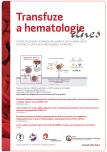Beta-thalassemia minor and maior in pregnancy
Authors:
J. Racková 1,2; M. Mrázek 2
Authors‘ workplace:
Gynekologicko-porodnická klinika 1. LF UK a Nemocnice Na Bulovce, Praha
1; Gynem s. r. o.
2
Published in:
Transfuze Hematol. dnes,28, 2022, No. 4, p. 228-232.
Category:
Case Report
doi:
https://doi.org/doi: 10.48095/cctahd2022228
Overview
We present a case of a 35-year-old primigravid nulliparous woman, which is a carrier of recessive form of beta thalassemia. Prior to the first visit at our clinic, the diagnosis was not genetically confirmed, it was based only on the blood-count in the childhood. Her partner also had childhood anaemia, and heterozygous form was suspected. They both underwent a genetic counselling; both were diagnosed with beta thalassemia minor by DNA sequencing. The first trimester foetal screening was negative, but the homozygous form of beta thalassemia was confirmed from a chorionic villus biopsy and subsequent genetic examination. Beta thalassemia maior is a serious congenital autosomal recessive disease with the highest incidence in subtropical geographical areas. Despite great progress in therapy, the morbidity and mortality of affected individuals remains high. Due to global social changes and migration, genetic rare diseases that did not occur in Central Europe may emerge. Healthcare should be well prepared and be able to cope with an effective primary and secondary prevention including the prenatal testing.
Keywords:
Beta-thalassemia – genetic counselling – preimplantation genetic dia gnosis – anaemia in pregnancy – non-invasive prenatal testing
Sources
1. Indrák K, Divoká M, Pospíšilová D, et al. Hemoglobinopatie. Vnitr Lek. 2018; 64 (5): 476–487.
2. Galanello R, Origa R. Beta-thalassemia. Orph J Rare Dis. 2010; 5: 11.
3. Weatherall DJ. Phenotype-genotype relationships in monogenic disease: lessons from the thalassaemias. Nat Rev Genet. 2001; 2 (4): 245–255.
4. Shang X, Xu X. Update in the genetics of thalassemia: What clinicians need to know. Best practice & research. Clin Obst Gynaecol. 2017; 39: 3–15.
5. Galanello R, Cao A. (1998). Relationship between genotype and phenotype. Thalassemia intermedia. Ann New York Acad Sci. 1998; 850: 325–333.
6. Fucharoen S, Winichagoon P. Haemoglobinopathies in Southeast Asia. Indian J Med Res. 2011; 134 (4): 498–506.
7. Modell B, Darlison M. Global epidemiology of haemoglobin disorders and derived service indicators. Bull WHO. 2008; 86 (6): 480–487.
8. Publikováno elektronicky: Family origin questionnaire. https: //assets.publishing.service.gov.uk/government/uploads/system/uploads/attachment_data/file/830289/SCT_Family_Origin_Questionnaire.pdf.
9. Kadyrov M, Kosanke G, Kingdom J, Kaufmann P. Increased fetoplacental angiogenesis during first trimester in anaemic women. Lancet. 1998; 352 (9142): 1747–1749.
10. Monni G, Peddes C, Iuculano A, Ibba RM. From prenatal to preimplantation genetic diagnosis of β-thalassemia. Prevention model in 8748 cases: 40 years of single center experience. J Clin Med. 2018; 7 (2): 35.
11. Traeger-Synodinos J. Preimplantation genetic diagnosis, an alternative to conventional prenatal diagnosis of the hemoglobinopathies. Int J Lab Hematol. 2013; 35 (6): 571–579.
12. Chen C, Li R, Sun J, et al. Noninvasive prenatal testing of a-thalassemia and β-thalassemia through population-based parental haplotyping. Genome Med. 2021; 13 (1): 18.
13. Čermák J, Válka J, Vostrý M, Škranc S, Beličková M. Centrum pro vzácné choroby červené krevní řady v Ústavu hematologie a krevní transfuze. Transfuze Hematol Dnes. 2017; 23 (Suppl 1): 76–86.
14. Aprile A, Sighinolfi S, Raggi L, Ferrari G. (2022). Targeting the hematopoietic stem cell niche in β-thalassemia and sickle cell disease. Pharmaceuticals. 2022; 15 (5): 592.
Labels
Haematology Internal medicine Clinical oncologyArticle was published in
Transfusion and Haematology Today

2022 Issue 4
Most read in this issue
- Haemolytic disease of the foetus and new-born
- Beta-thalassemia minor and maior in pregnancy
- Current experience with ropeginterferon Alfa-2b in Ph negative myeloproliferative neoplasm at the Department of Internal Medicine – Haematology and Oncology in Brno
- How do anti-SARS-CoV-2 IgG and IgM predict the titre of virus-neutralizing antibodies in donors of convalescent plasma against COVID-19 disease?
